美国文学第5周超验主义
- 格式:ppt
- 大小:475.00 KB
- 文档页数:32
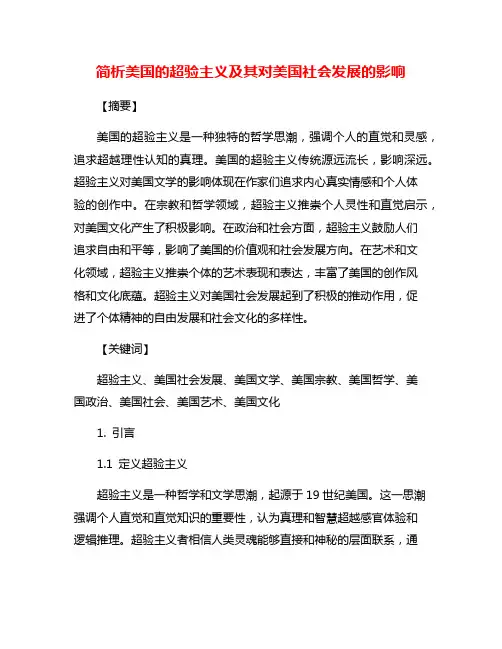
简析美国的超验主义及其对美国社会发展的影响【摘要】美国的超验主义是一种独特的哲学思潮,强调个人的直觉和灵感,追求超越理性认知的真理。
美国的超验主义传统源远流长,影响深远。
超验主义对美国文学的影响体现在作家们追求内心真实情感和个人体验的创作中。
在宗教和哲学领域,超验主义推崇个人灵性和直觉启示,对美国文化产生了积极影响。
在政治和社会方面,超验主义鼓励人们追求自由和平等,影响了美国的价值观和社会发展方向。
在艺术和文化领域,超验主义推崇个体的艺术表现和表达,丰富了美国的创作风格和文化底蕴。
超验主义对美国社会发展起到了积极的推动作用,促进了个体精神的自由发展和社会文化的多样性。
【关键词】超验主义、美国社会发展、美国文学、美国宗教、美国哲学、美国政治、美国社会、美国艺术、美国文化1. 引言1.1 定义超验主义超验主义是一种哲学和文学思潮,起源于19世纪美国。
这一思潮强调个人直觉和直觉知识的重要性,认为真理和智慧超越感官体验和逻辑推理。
超验主义者相信人类灵魂能够直接和神秘的层面联系,通过这种联系获取智慧和启示。
他们追求的是超越理性和经验的真实知识,通过直觉和感知来认识世界和自我。
在超验主义的世界观中,个人的内心和灵魂是最重要的,他们认为人类的灵魂具有无限的力量和智慧,可以直接与神秘的神性联系。
超验主义强调直觉和感知的重要性,认为通过深入的沉思和直觉体验,人类可以超越理性和经验的限制,接近真理和智慧的源泉。
超验主义是一种强调个人内在力量和直觉知识的哲学思潮,认为人类可以通过直觉和感知认识世界和自我,超越理性和经验的局限。
这种思想在19世纪美国的文学、宗教、哲学、政治、艺术和文化领域都有着深远的影响,对美国社会发展产生了重要的影响。
1.2 美国的超验主义传统美国的超验主义传统源自于19世纪初期的新英格兰地区,具有强烈的个人主义和反传统思想。
超验主义者强调个人直觉和经验,认为真理超越了理性和经验的限制。
他们主张通过直接体验自然和神秘领域来获取真知,反对社会规范和传统权威。
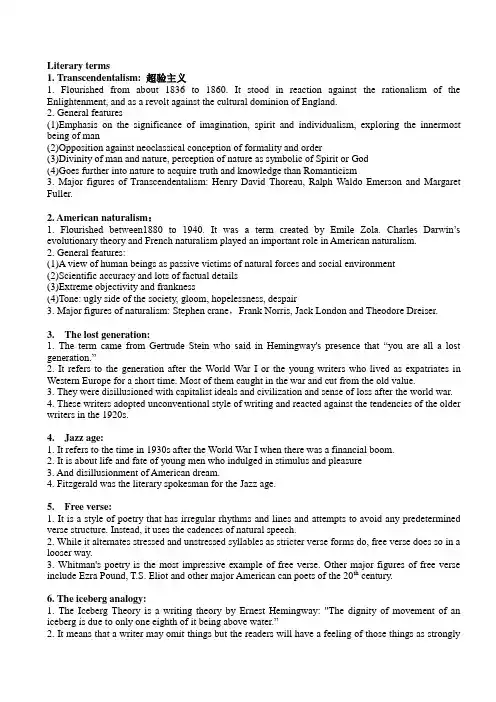
Literary terms1. Transcendentalism: 超验主义1. Flourished from about 1836 to 1860. It stood in reaction against the rationalism of the Enlightenment, and as a revolt against the cultural dominion of England.2. General features(1)Emphasis on the significance of imagination, spirit and individualism, exploring the innermost being of man(2)Opposition against neoclassical conception of formality and order(3)Divinity of man and nature, perception of nature as symbolic of Spirit or God(4)Goes further into nature to acquire truth and knowledge than Romanticism3. Major figures of Transcendentalism: Henry David Thoreau, Ralph Waldo Emerson and Margaret Fuller.2. American naturalism:1. Flourished between1880 to 1940. It was a term created by Emile Zola. Charles Darwin‟s evolutionary theory and French naturalism played an important role in American naturalism.2. General features:(1)A view of human beings as passive victims of natural forces and social environment(2)Scientific accuracy and lots of factual details(3)Extreme objectivity and frankness(4)Tone: ugly side of the society, gloom, hopelessness, despair3. Major figures of naturalism: Stephen crane,Frank Norris, Jack London and Theodore Dreiser.3.The lost generation:1. The term came from Gertrude Stein who said in Hemingway's presence that “you are all a lost generation.”2. It refers to the generation after the World War I or the young writers who lived as expatriates in Western Europe for a short time. Most of them caught in the war and cut from the old value.3. They were disillusioned with capitalist ideals and civilization and sense of loss after the world war.4. These writers adopted unconventional style of writing and reacted against the tendencies of the older writers in the 1920s.4.Jazz age:1. It refers to the time in 1930s after the World War I when there was a financial boom.2. It is about life and fate of young men who indulged in stimulus and pleasure3. And disillusionment of American dream.4. Fitzgerald was the literary spokesman for the Jazz age.5.Free verse:1. It is a style of poetry that has irregular rhythms and lines and attempts to avoid any predetermined verse structure. Instead, it uses the cadences of natural speech.2. While it alternates stressed and unstressed syllables as stricter verse forms do, free verse does so in a looser way.3. Whitman's poetry is the most impressive example of free verse. Other major figures of free verse include Ezra Pound, T.S. Eliot and other major American can poets of the 20th century.6. The iceberg analogy:1. The Iceberg Theory is a writing theory by Ernest Hemingway: "The dignity of movement of an iceberg is due to only one eighth of it being above water.”2. It means that a writer may omit things but the readers will have a feeling of those things as stronglyas though the writer had stated them if the writer is writing truly enough.3. It was well suited to evoke the stoic courage of his characters who face lonely and thankless tasks. 1.Poe's Poetic Ideas1. Poe believes that Poetry is not to summarize and interpret earthly experience, but the elevation of excitement of the soul should be “the poetic principle”. The best poetic topic is perishing of beauty, or “supernal beauty”.2. Everything that detains human soul must be excluded from the poetry, including moral sense.3. Poe defines poetry as “the rhythmical creation of beauty”, giving emphasis upon the importance of the rhythmical or musical element in poetry.2.Whitman's style1. Transcendentalism: optimism, divinity of man and nature, emphasis on individualism and exploring the innermost of being of man.2. Democratic thought: celebration of ideal democratic society and attacks against corruption3. The sprawling lines: extremely long.4. Parallelism: the parallel lines say the same thing but use different words.5. Envelope structure: the first line begins with the subject, and then more and more lines list modifiers till the verb appears in the last line of the stanza. This is like enclosing a whole list of ideas in an envelope.6. Catalogue technique: means listing. Typical poems by Whitman make long, long lists of images, of sights, sounds, smells, taste, and touch.7. No conventional meter and rhythm8. The verse unit is usually an independent clause.3.Formal features of Dickinson's poetry1. Based on her own experience2. Theme: love, nature, friendship, death and immorality3. Peculiar poetic form: abundant dashes, irregular punctuation and capitalization, faulty grammar, no title, no regular line4. Remarkable for its uncommon variety, original subtlety and unusual richness5. Poetic indirection: e.g. “There is certain slant of light” and “Tell all the truth but tell its slant!”4.The theme and techniques in Eliot's "The W aste Land"Theme:1. Modern spiritual barrenness,2. Despair and depression that followed the WWI3. Sterility and turbulence of the modern world, and the decline and break-down of western culture4. Shows the search for regeneration by people living in a chaotic world.Technique: 1. V aried length and rhythm to harmonize with the changing subject matter2. Unrhymed lines,3. Lots of borrowings from different writers5.Analysis of "Richard Cory" by Edwin Arlington Robinson1. Theme:It seems that Cory‟s life should be a happy and successful one, but his inner world is far more complicated than what he appears to be. It tells us that success may be meaningless to somepeople and cannot reflect the true meaning and value of life and shows the hollowness and loneliness of modern people.2. TechniqueWording: (1)Lively words: “imperially”; “quietly”; “admirably”(2)Simple words: looked at;clean favored;was arrayed;glittered; was human; put a bullet through his head(3)Simple words to show contrast between the cheering life and the tragic ending(4)Ancient words: …clean favored‟、…arrayed‟、…schooled‟to correspond the serious topic Unexpected ending, sharp contrast and mild sarcasm, leaving great room for readers to think about the topicPoetic sounds: Traditional pentameter with a rhyming scheme of“abab, cdcd,elef, ghgh”6. Comment on “Stopping by W oods on a Snowy Evening" by Robert FrostSummary and Theme:The speaker is stopping by some woods on a snowy evening. He or she takes in the lovely scene in near-silence, is tempted to stay longer, but acknowledges the obligations and duties yet to be fulfilled before he or she can rest for the night. In this poem, Robert Frost discusses the relation between mortal obligations and the eternal rest.Form:The poem consists of four (almost) identically constructed stanzas. Each line is iambic, with four stressed syllables:Features of content:1. Plain in words, but profound in meaning. Simple words with far-reaching meanings2. Since it is full of symbolic constructs, it is thought- provoking, and the readers can get great fun in developing the subtext.Detailed analysis:In the first stanza, the poet leads us to a piece of beautiful woods filled up with snow. As we all know that the woods are usually linked with myth, the unknown world, and the utmost tranquility. We can guess that, in this poem, the poet takes the woods as the eternal life, the bliss, that is to say the Heaven. He is fed up with the routine duties, and wants to rest forever. The woods happens to provide an ideal place.Then it comes to the snowy evening. “It is the darkest evening of the year.” The snow is cold and the evening dark, all of which indicate that the poet is depressed inside. His subconscious wants him to s top, but his “little horse” with the inspiring bells, which is actually a symbol of vitality, urges him to go. In the second stanza, the poet uses “frozen lake” to denote death. Why he transfers the embodiment of death from the beautiful “woods” to the deadly “frozen lake” is because the point of view has changed from the poet to the little horse.In the third stanza, the little horse wonders why the poet stops when he should go on. Only “the easy wind” and “downy flake” answer it with soft sweep. We can imagine the scene: the “downy flake” is so light and gentle that it flies in the soft wind. Thus we can get the idea: the poet‟s answer is as slight and uncertain as the flakes, because he himself doesn‟t know why he stops suddenly in the woods.Toward the end, the poet comes back from the illusion. Though the woods are attractive, he must move on, because he has promise to keep. “The promise” could be an obligation or a goal. One cannotdie before fulfilling one‟s dream. The poet uses “sleep” to represent death, just as we usually do.7.Theme and technique in The Great Gatsby by FitzgeraldTheme:It resents the decline of the American dream in1920s, the hollowness of the upper class and the falseness of ideals and moves toward disillusion. It also shows that will not to a perfect country. Instead, it leads total depravity. The nationals become hypocritical, indifferent, empty, and cruel, day and night indulged in material pursuing.Technique:1. Development of traditional narrative techniques and first-person narrator: The whole novel proceeded with Nick‟s narration.2. Two main clues of the story: The main clue is the imbroglio between Gatsby and the family of Tom, and the minor one is the imbroglio between Tom and the family of Wilson.3. The contrastive techniques endow the novel with artistic glamour and profound connotation.4. Technique of delayed character revelation to emphasize the theatrical quality of Gatsby‟s approach to lifement on Hemingway's style and Farewell to Arms"Style:1. News reporting style: direct, concise, life-like dialogues, less ornaments2. Iceberg theory: omit something but the readers will still have a feeling of those things as strongly as though the writer had stated them thanks to the direct and true description.3. The Loss generation: people disillusioned after the world war by old values and insensitivity and hollowness of society4. Hemingway code heroes: (1) physically strong, (2) endowed with certain skills, (3)strong will power(Man can be destroyed, not defeated; Courage=grace under pressure), (4)tested in difficulties Farewell to ArmsThemes:The grim reality of war, the relationship between love and pain, feelings of lossMotifs:Masculinity, games and divertissement, loyalty versus abandonment, illusions and fantasies, alcoholismSymbols: Rain serves in the novel as a potent symbol of the inevitable disintegration of happiness in life. Catherine‟s hair9.Analyze "Dry September" by William Faulkner1. “Dry September” was written in 1931, and is a well-known story of Faulkner.2. This story touches upon the strange relationship between sex and violence, examines the psychological state of the main characters, and exposes the crime of racial discrimination which makes one bristle with anger.3. The tone of this story contributes much to its effectiveness, particularly to the imagery of infernal heat and dryness and to the setting itself.4. From the character Miss Minnie the reader could perceive the obvious impact of Freud‟s ideas on William Faulkner.。
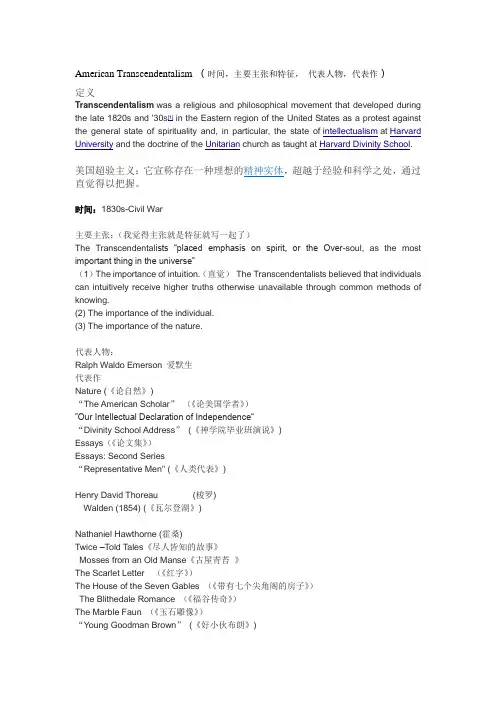
American Transcendentalism (时间,主要主张和特征,代表人物,代表作)定义Transcendentalism was a religious and philosophical movement that developed during the late 1820s and '30s[1] in the Eastern region of the United States as a protest against the general state of spirituality and, in particular, the state of intellectualism at Harvard University and the doctrine of the Unitarian church as taught at Harvard Divinity School.美国超验主义:它宣称存在一种理想的精神实体,超越于经验和科学之处,通过直觉得以把握。
时间:1830s-Civil War主要主张:(我觉得主张就是特征就写一起了)The Transcendental ists “placed emphasis on spirit, or the Over-soul, as the most important thing in the universe”(1)The importance of intuition.(直觉)The Transcendentalists believed that individuals can intuitively receive higher truths otherwise unavailable through common methods of knowing.(2) The importance of the individual.(3) The importance of the nature.代表人物:Ralph Waldo Emerson 爱默生代表作Nature (《论自然》)“The American Scholar”(《论美国学者》)”Our Intellectual Declaration of Independence““Divinity School Address”(《神学院毕业班演说》)Essays(《论文集》)Essays: Second Series“Representative Men" (《人类代表》)Henry David Thoreau (梭罗)Walden (1854) (《瓦尔登湖》)Nathaniel Hawthorne (霍桑)Twice –Told Tales《尽人皆知的故事》Mosses from an Old Manse《古屋青苔》The Scarlet Letter (《红字》)The House of the Seven Gables (《带有七个尖角阁的房子》)The Blithedale Romance (《福谷传奇》)The Marble Faun (《玉石雕像》)“Young Goodman Brown”(《好小伙布朗》)Henry Wadsworth Longfellow亨利.华兹沃斯.朗费罗Voices of the Night (1839) 《夜籁集》-- catch the attentionBallads and Other Poems (1841) 《歌谣及其它》Evangeline (1847) 《伊凡吉林》Hiawatha or The Song of Hiawatha (1855)《海华莎之歌》Imagism (时间,对Image 的定义,主要主张和特征,代表人物,代表作)定义Imagism was poetic movement of England and the united states, flourishing from 1909-1917. Its credo, expressed in some imagist poets, includes the use of precise language, the creation of new rhythms, absolute freedom in choice of subject matter, and the evocation of concrete images.时间:between the years 1909 and 1917特征:(1) “Direct treatment of the 'thing' whet h er subjective or objective;”(2) “To use absolutely no word that does not contribute to the presentation;”(3) “As regarding rhythm: to compose in the sequence of musical phrase, not in sequence of a metronome(节拍器).”主张:It came into being as a reaction to the traditional English poetry characterized by cloudy verbiage, and aimed instead at a new clarity and exactness in the short lyric poem.代表人物:Ezra Pound“The Cantos”。
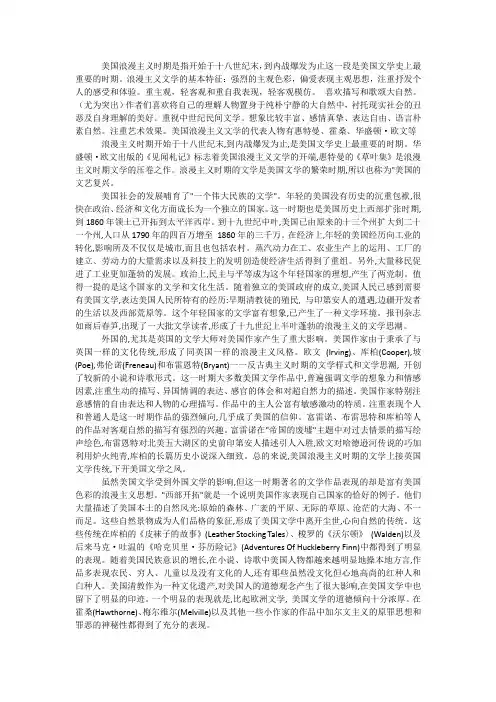
美国浪漫主义时期是指开始于十八世纪末,到内战爆发为止这一段是美国文学史上最重要的时期。
浪漫主义文学的基本特征:强烈的主观色彩,偏爱表现主观思想,注重抒发个人的感受和体验。
重主观,轻客观和重自我表现,轻客观模仿。
喜欢描写和歌颂大自然。
(尤为突出)作者们喜欢将自己的理解人物置身于纯朴宁静的大自然中,衬托现实社会的丑恶及自身理解的美好。
重视中世纪民间文学。
想象比较丰富、感情真挚、表达自由、语言朴素自然。
注重艺术效果。
美国浪漫主义文学的代表人物有惠特曼、霍桑、华盛顿·欧文等浪漫主义时期开始于十八世纪末,到内战爆发为止,是美国文学史上最重要的时期。
华盛顿·欧文出版的《见闻札记》标志着美国浪漫主义文学的开端,惠特曼的《草叶集》是浪漫主义时期文学的压卷之作。
浪漫主义时期的文学是美国文学的繁荣时期,所以也称为"美国的文艺复兴。
美国社会的发展哺育了"一个伟大民族的文学"。
年轻的美国没有历史的沉重包袱,很快在政治、经济和文化方面成长为一个独立的国家。
这一时期也是美国历史上西部扩张时期,到1860年领土已开拓到太平洋西岸。
到十九世纪中叶,美国已由原来的十三个州扩大到二十一个州,人口从1790年的四百万增至1860年的三千万。
在经济上,年轻的美国经历向工业的转化,影响所及不仅仅是城市,而且也包括农村。
蒸汽动力在工、农业生产上的运用、工厂的建立、劳动力的大量需求以及科技上的发明创造使经济生活得到了重组。
另外,大量移民促进了工业更加蓬勃的发展。
政治上,民主与平等成为这个年轻国家的理想,产生了两党制。
值得一提的是这个国家的文学和文化生活。
随着独立的美国政府的成立,美国人民已感到需要有美国文学,表达美国人民所特有的经历:早期清教徒的殖民, 与印第安人的遭遇,边疆开发者的生活以及西部荒原等。
这个年轻国家的文学富有想象,已产生了一种文学环境。
报刊杂志如雨后春笋,出现了一大批文学读者,形成了十九世纪上半叶蓬勃的浪漫主义的文学思潮。
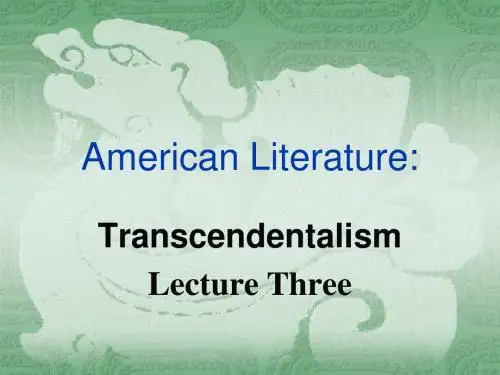

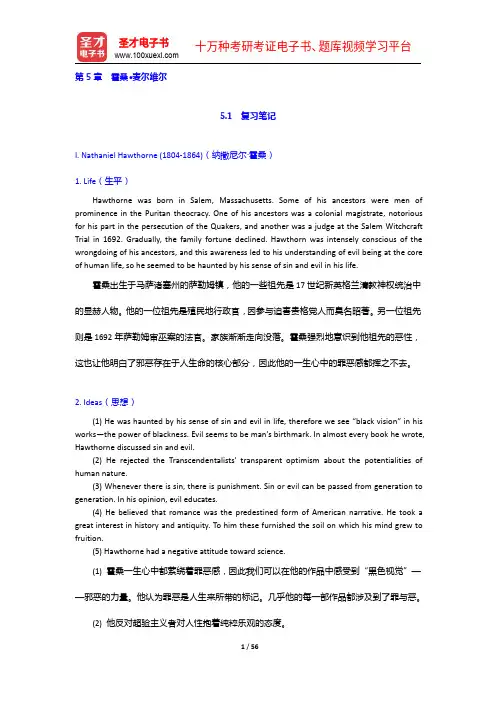
第5章霍桑•麦尔维尔5.1复习笔记I.Nathaniel Hawthorne(1804-1864)(纳撒尼尔·霍桑)1.Life(生平)Hawthorne was born in Salem,Massachusetts.Some of his ancestors were men of prominence in the Puritan theocracy.One of his ancestors was a colonial magistrate,notorious for his part in the persecution of the Quakers,and another was a judge at the Salem Witchcraft Trial in1692.Gradually,the family fortune declined.Hawthorn was intensely conscious of the wrongdoing of his ancestors,and this awareness led to his understanding of evil being at the core of human life,so he seemed to be haunted by his sense of sin and evil in his life.霍桑出生于马萨诸塞州的萨勒姆镇,他的一些祖先是17世纪新英格兰清教神权统治中的显赫人物。
他的一位祖先是殖民地行政官,因参与迫害贵格党人而臭名昭著。
另一位祖先则是1692年萨勒姆审巫案的法官。
家族渐渐走向没落。
霍桑强烈地意识到他祖先的恶性,这也让他明白了邪恶存在于人生命的核心部分,因此他的一生心中的罪恶感都挥之不去。
2.Ideas(思想)(1)He was haunted by his sense of sin and evil in life,therefore we see“black vision”in his works—the power of blackness.Evil seems to be man’s birthmark.In almost every book he wrote, Hawthorne discussed sin and evil.(2)He rejected the Transcendentalists'transparent optimism about the potentialities of human nature.(3)Whenever there is sin,there is punishment.Sin or evil can be passed from generation to generation.In his opinion,evil educates.(4)He believed that romance was the predestined form of American narrative.He took a great interest in history and antiquity.To him these furnished the soil on which his mind grew to fruition.(5)Hawthorne had a negative attitude toward science.(1)霍桑一生心中都萦绕着罪恶感,因此我们可以在他的作品中感受到“黑色视觉”——邪恶的力量。
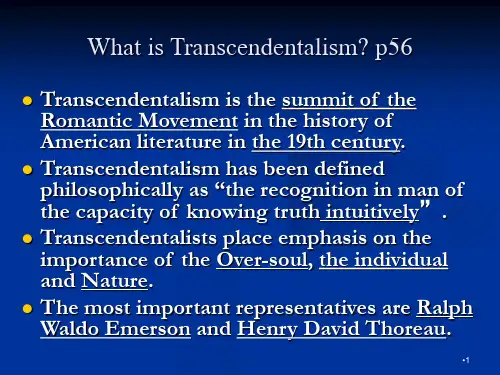
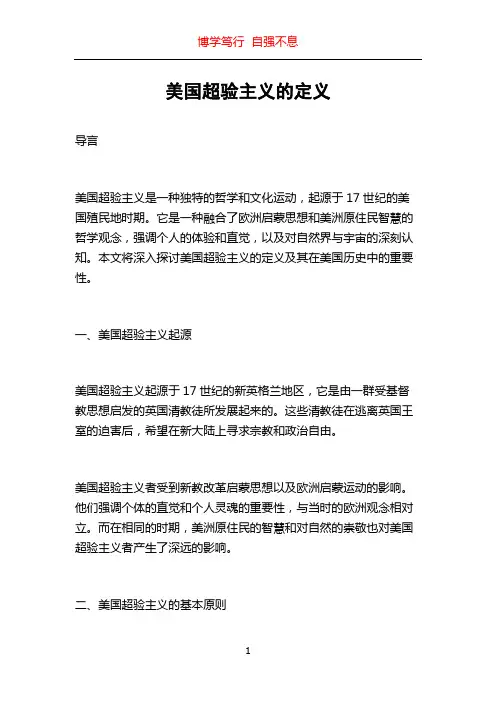
美国超验主义的定义导言美国超验主义是一种独特的哲学和文化运动,起源于17世纪的美国殖民地时期。
它是一种融合了欧洲启蒙思想和美洲原住民智慧的哲学观念,强调个人的体验和直觉,以及对自然界与宇宙的深刻认知。
本文将深入探讨美国超验主义的定义及其在美国历史中的重要性。
一、美国超验主义起源美国超验主义起源于17世纪的新英格兰地区,它是由一群受基督教思想启发的英国清教徒所发展起来的。
这些清教徒在逃离英国王室的迫害后,希望在新大陆上寻求宗教和政治自由。
美国超验主义者受到新教改革启蒙思想以及欧洲启蒙运动的影响。
他们强调个体的直觉和个人灵魂的重要性,与当时的欧洲观念相对立。
而在相同的时期,美洲原住民的智慧和对自然的崇敬也对美国超验主义者产生了深远的影响。
二、美国超验主义的基本原则1. 直觉主义:美国超验主义者相信个体的直觉是获得真理的最重要方法。
他们认为人类可以通过直觉和体验来获得知识,而不仅仅依赖于传统的权威或逻辑推理。
2. 宇宙的普遍性:美国超验主义者相信宇宙中的一切都是相互联系的,并且人类的灵魂与宇宙紧密相连。
他们认为个体的存在是宇宙的一部分,人们可以通过与宇宙的联系来获得智慧和和谐。
3. 自然界的尊重:美国超验主义者崇尚自然界的美与力量,并对自然界保持敬畏之心。
他们认为与自然界和谐相处可以带来心灵的平静与幸福。
三、美国超验主义的学派和代表人物美国超验主义发展出了几个不同的学派,每个学派都有其独特的哲学观点和代表人物。
1. 第一代超验主义者:代表人物包括拉尔夫·沃尔多·爱默生、亨利·大卫·梭罗和玛格丽特·富勒等。
他们强调个体的直觉和内在精神,主张独立思考和自由的生活方式。
2. 第二代超验主义者:代表人物包括乔治·赫伯特·梅、詹姆斯·拉塞尔·洛厄尔和兰斯洛特·普康特等。
他们继承了第一代超验主义者的思想,但更加注重社会改革和人类进步。
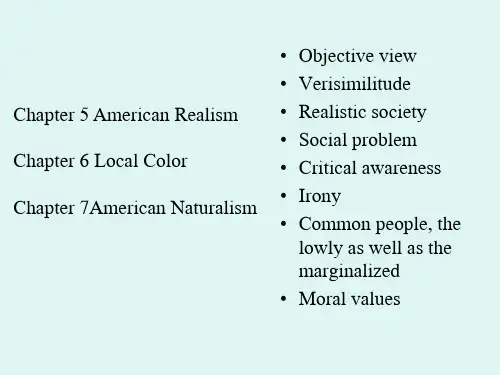
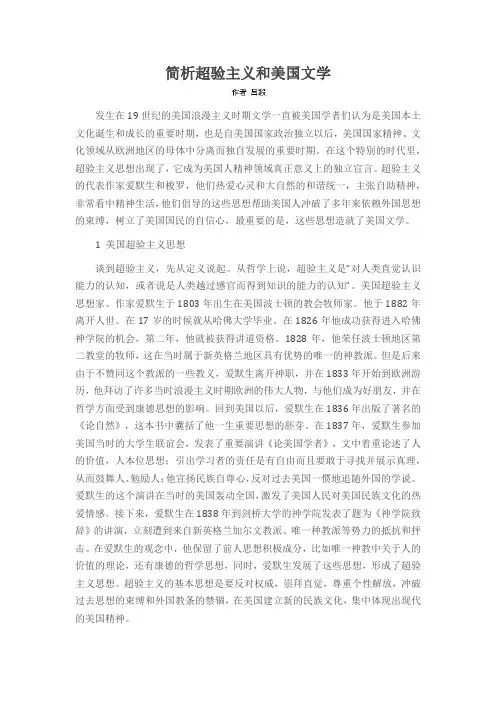
简析超验主义和美国文学发生在19世纪的美国浪漫主义时期文学一直被美国学者们认为是美国本土文化诞生和成长的重要时期,也是自美国国家政治独立以后,美国国家精神、文化领域从欧洲地区的母体中分离而独自发展的重要时期。
在这个特别的时代里,超验主义思想出现了,它成为美国人精神领域真正意义上的独立宣言。
超验主义的代表作家爱默生和梭罗,他们热爱心灵和大自然的和谐统一,主张自助精神,非常看中精神生活,他们倡导的这些思想帮助美国人冲破了多年来依赖外国思想的束缚,树立了美国国民的自信心,最重要的是,这些思想造就了美国文学。
1 美国超验主义思想谈到超验主义,先从定义说起。
从哲学上说,超验主义是“对人类直觉认识能力的认知,或者说是人类越过感官而得到知识的能力的认知”。
美国超验主义思想家、作家爱默生于1803年出生在美国波士顿的教会牧师家。
他于1882年离开人世。
在17岁的时候就从哈佛大学毕业。
在1826年他成功获得进入哈佛神学院的机会,第二年,他就被获得讲道资格。
1828年,他荣任波士顿地区第二教堂的牧师,这在当时属于新英格兰地区具有优势的唯一的神教派。
但是后来由于不赞同这个教派的一些教义,爱默生离开神职,并在1833年开始到欧洲游历,他拜访了许多当时浪漫主义时期欧洲的伟大人物,与他们成为好朋友,并在哲学方面受到康德思想的影响。
回到美国以后,爱默生在1836年出版了著名的《论自然》,这本书中囊括了他一生重要思想的胚芽。
在1837年,爱默生参加美国当时的大学生联谊会,发表了重要演讲《论美国学者》,文中着重论述了人的价值,人本位思想;引出学习者的责任是有自由而且要敢于寻找并展示真理,从而鼓舞人、勉励人;他宣扬民族自尊心,反对过去美国一惯地追随外国的学说。
爱默生的这个演讲在当时的美国轰动全国,激发了美国人民对美国民族文化的热爱情感。
接下来,爱默生在1838年到剑桥大学的神学院发表了题为《神学院致辞》的讲演,立刻遭到来自新英格兰加尔文教派、唯一种教派等势力的抵抗和抨击。
美国超验主义(American Transcendentalism)是美国的一个重要思潮,它兴起于十九世纪三十年代的新英格兰地区,但波及其他地方,成为美国思想史上一次重要的思想解放运动。
它是与拉尔夫·沃尔多·爱默生以及梭罗相关的一种文学和哲学运动,宣称存在一种理想的精神实体,超越于经验和科学之处,通过直觉得以把握。
超验主义是美国文学的第三个阶段,真正开始影响美国的文学风格。
超验主义的主要思想观点有三。
首先,超验主义者强调精神,或超灵,认为这是宇宙至为重要的存在因素。
超灵是一种无所不容、无所不在、扬善抑恶的力量,是万物之本、万物之所属,它存在于人和自然界内。
其二,超验主义者强调个人的重要性。
他们认为个人是社会的最重要的组成部分,社会的革新只能通过个人的修养和完善才能实现。
因此人的首要责任就是自我完善,而不是刻意追求金玉富贵。
理想的人是依靠自己的人。
其三,超验主义者以全新的目光看待自然,认为自然界是超灵或上帝的象征。
在他们看来,自然界不只是物质而已。
它有生命,上帝的精神充溢其中,它是超灵的外衣。
因此,它对人的思想具有一种健康的滋补作用。
超验主义主张回归自然,接受它的影响,以在精神上成为完人。
这种观点的自然内涵是,自然界万物具象征意义,外部世界是精神世界的体现。
爱默生的超验主义名词解释超验主义是19世纪美国经典文学家拉尔夫·沃尔多·爱默生的重要思想体系,该思想对于美国文学和哲学的发展起到了巨大的推动作用。
本文将就超验主义进行解释,探讨其重要概念和原则,并分析其在文学和思想领域的影响。
一、超验主义的核心概念超验主义的核心概念是“自我实现”和“灵魂的与自然的统一”。
爱默生认为,个体应该追求真理和完善自己,而不是依赖传统的道德规范或亲身经验。
他强调自觉的想象力和独立的思考,通过这些能力人们可以探索于自然相连的真实自我和世界的奥秘。
二、自我实现的重要性超验主义强调自我实现的重要性,追求个体的本真和灵魂的发展。
这种观点对于当时社会中陈旧的道德观念提出了挑战。
爱默生主张人们要相信自己独特的能力和价值,并通过追求自我实现来建立更加真实和有意义的生活。
三、与自然的统一超验主义认为与自然的统一是一种内在的关系,人类和自然的界限并不存在。
爱默生强调人们应该与自然保持坦诚和和谐的联系,以此来寻找真理和智慧。
这种观点对于当时的工业化社会提出了批判,呼吁人们重新与大自然建立和谐的联结。
四、超验主义对文学的影响超验主义对美国文学产生了深远的影响。
不少美国作家受到其思想启发,以独特的方式表达了自我实现和与自然的统一。
例如,亨利·大卫·梭罗的著名作品《瓦尔登湖》中,他以与大自然和平共处的经验来追求自我实现。
此外,诗人沃尔特·惠特曼的《草叶集》通过描绘个人与自然的合一来表达了超验主义的核心观点。
五、超验主义对思想的影响超验主义的思想也对后续的哲学思想产生了重要影响。
它对于存在主义和后现代主义的形成有着重要意义。
爱默生的超验主义思想使人们开始关注个体的自由与选择,以及个人认知的相对性。
这些思想推动了现代哲学对于自我和真理的反思。
六、超验主义的局限性超验主义也存在着一些局限性。
其过分强调个体的独特性和自主性,可能导致个人主义的极端。
此外,忽视了社会和集体的重要性,对于社会责任的缺位使超验主义难以实际应用于公共生活和社会发展。
第6章超验主义和符号表征Questions for Discussion and Writing Assignments1. Give a brief account of how Transcendentalism came into being.Key: In 1836, an informal group met in Concord, Massachusetts, to discuss theology, philosophy, and literature. At first they called themselves the Symposium of Hedge Club, after Henry Hedge who had initiated the meetings. But good-intentioned neighbors began calling the group members Transcendentalists since they always engaged in lofty discourses. The group accepted the name. Thus, Transcendentalism came into being.2. Discuss the general philosophy of Transcendentalism in terms of its connections with romanticism, its “epistemology,” its emphasis on symbolic representation on individualism, and its philosophical sources.Key: As an intensified expression of romanticism, Transcendentalism shares the characteristics of romanticism such as: the importance of intuition, the exaltation of the individual over society, the new and thrilling delight in nature, fascination with the Gothic and the “Oriental,” and the desire to build a national literature and culture. In addition, Transcendentalism, as a type of romanticism peculiar to New England, took on a specific moral and philosophical tone. The moral implications came from the environment where Puritan idealism persisted, andthe philosophical tone was largely defined by Emerson.As an epistemology, Transcendentalism believes that individuals can intuitively receive higher truths otherwise unavailable through common methods of knowing, thus transcending the limits of rationalism.Translated into literature, this belief became an emphasis on symbolic representation. As formulated by Emerson, this became a call for action encouraging the Young not to be enslaved by customs but to follow the God within, and to live every moment with a strenuousness such as found in the Puritan fathers. However, insofar as nature is believed to be the morally good proving God’s presence everywhere in his creation and that human nature is accordingly all good, Transcendentalism was the reversed form of Calvinism. The kind of mysticism characterizing Transcendentalism had always lurked within Puritanism, not in its main doctrines, but in the rebellious beliefs such as Hutcinson’s belief in “direct revelation.”Transcendentalism does not have the kind of logical consistency one would normally associate with a philosophy, but this inconsistency may not be a weakness. In addition, the inconsistency is due to the fact that Transcendentalism absorbed many sources of influence. Three such sources can be identified. The first source is neo-Platonism, the belief that spirit prevails over matter and that there is an ascending scale of spiritual values rising to absolute Good. The second source is German romanticism, transmitted through the writings of Coleridge and Carlyle, which emphasizes intuition as a means of piercing to the real essence ofthings. The third source of influence is a certain version of Eastern mysticism, gleaned and interpreted from ancient Asian scriptures, including, to a limited extent, those by Confucius.3. With “Nature,” “The Over-Soul” and “Compensation” as examples, discuss Emerson’s philosophy in terms of pantheism, romanticism and his connection with Asian cultures.Key: Emerson is a fervent defender of individualism, which is celebrated by Romanticism fervidly. And his sense of individualism is associated with a certain kind of pantheism. As he envisioned it in his lecture “The Over-Soul,” the souls of all individuals commune with the great universal soul. The all-present spiritual nature corresponds to the divine intuition of an individual. This correspondence or communion in turn defines Emerson’s idea of the organic art. Specifically, art is organic in a double sense: the appropriate form is the expression of the poet’s intuition; this intuition is in turn a welling out from the universal mind, the “Over-Soul” suggestive of pantheism. Since the universal mind is the ultimate creator, an individual who wants to partake in the creative process must submit himself to this primal source.In Nature, Em erson states: “I become a transparent eye-ball. I am nothing. I see all. The currents of the Universal Being circulate through me; I am a particle of God.” That the individual soul can become the medium of the divine forces of Nature is at the heart of this book.“Compensation” is the essay that should be read in conjunction with “The Over-Soul.” If the Over-Soul is all powerful and at the same time good, does evil exist? Emerson’s answer is that it does not exist. To put it differently, evil—the opposite of good—is powerless to affect anything. Evil deeds do occur, causing temporary unbalances. But for each “evil” deed there is a corresponding “good” one. Every apparent “gain” then carries with it the price tag of a corresponding “loss.” The resemblance of Emerson’s philosophy with ancient Asian philosophy is now evident: the Over-Soul with Brahma, Compensation with Karma.It has been pointed out that Emerson learned from Confucius. Indeed, Emerson, copied aphorisms from Confucius in his Journals, mentioned Confucius in his essays, and published his translation of selected sayings of Confucius in The Dial. But Emerson’s connection with Confucius was more out of a respect for an ancient sage than an affinity with a kindred spirit. In many ways, Emerson’s philosophy is the antidote to Confucianism.4. Write a research essay to compare Emerson’s comments on Jesus Christ in “The Divinity School Address” with Thomas Paine’s in The Age of Reason. Key: “Divinity School Address” is a very famous speech of Emerson. It was delivered at the request of some graduates of the Harvard Divinity School and caused what a scholar later called a “Tempest in a Boston Tea cup.” Emerson asserted the divinity of all men, thus treating Christ too as a human. As it was alsoconspicuous in an address for the Divinity School, Emerson did not quote or discuss the Bible, used no prayer, and denied the truth of miracles as taught by the church. What Emerson emphasized as being divine is the majesty of the individual soul, a theme consistent in all his writings. “If a man is at heart just, then in so far is he God.” This address’s insistence on the importance of intuition also refutes the Church’s authority in asserting or communicating “truth.”Thomas Paine’s The Age of Reason challenges institutionalized religion and the legitimacy of the Bible, the central text of Christianity. It caused a short-lived deistic revival. The Age of Reason presents common deistic arguments. For example, it highlights what Paine saw as corruption of the Christian Church and criticizes its efforts to acquire political power. Paine advocates reason in the place of revelation, leading him to reject miracles and to view the Bible as an ordinary piece of literature rather than as a divinely inspired text. It promotes natural religion and argues for the existence of a creator-God.5. What is M argaret Fuller’ s position regarding women and gender equality? Key: Fuller’s surviving writings, especially her principal book Woman in the Nineteenth Century have established her as a persuasive advocate for women’s rights. In opposition to Emerson, Fuller argued that women, just like men, were also inherently divine. Therefore, women should have the same right and opportunity to inner and outer self-development as men. Fuller thought thatwomen must rely on themselves if they wanted to improve their social Conditions. Fuller’s vision of gender equality is not unrelated to her view that all humans are androgynous: No man is wholly masculine; nor is any woman completely feminine. In her portrait of Miranda, Fuller created the image of her idealized womanhood. This idealized woman should be self-reliant, is willing to help other women, and she must be able to make choices for herself.6. How is Thoreau’s revolt m anifested both in his social actions and in his writing? What is the nature of his revolt? What is his role in Transcendentalism?Key: What Thoreau revolted against in Walden was the materialism of his day. Or, more specifically, he objected to the division of labor that the emerging industrialism threatened to bring about. On July 4, 1845, Thoreau began living in a hut, which was built on Emerson’s land, by the Walden Pond. There he lived simply and deliberately, devoting his time to observations and reflections. And there, he once refused to pay tax to protest against the Mexican War and was imprisoned for it.Thoreau, along with Emerson, was the most important representative of the Transcendentalism. Both his works and his actions have influenced later generations deeply. Although Thoreau was Emerson’s disciple, he was not a lesser Emerson but a unique voice and personality. Thoreau practiced the self-reflective and self-reliant Transcendentalism that Emerson preached. Emerson found Thoreau’s outdoor vig or and sharp individuality captivating.。